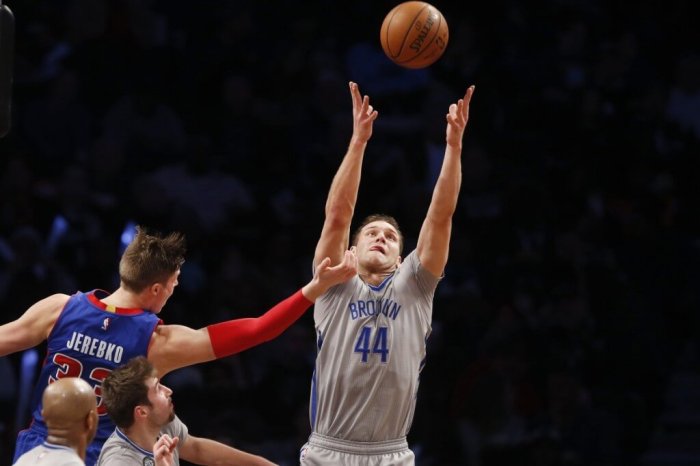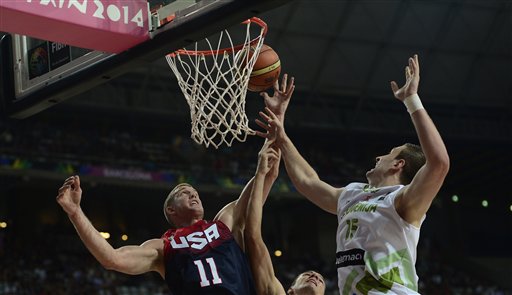The Oklahoma City Thunder made an improbable comeback in Saturday night’s game to complete a sweep of the Dallas Mavericks. Down 86-73 with 9:44 left in the fourth quarter, the Thunder rattled off two runs to reclaim control: a 15-2 run to tie the game at 88 with 6:05 remaining, then an 8-0 run to put the team up 96-91 with 3:00 left. It wasn’t the shooting of Kevin Durant or the athleticism of Russell Westbrook that carried the Thunder back, it was one James Harden that ran the show.
By repeating a play called “Angle,” a pick-and-roll at the top of the key, with Harden as the playmaker and either Nick Collison or Serge Ibaka as the screener, Harden got into the lane with ease, hitting six field goals either at the rim or in the space directly in front of it in those final nine minutes.
So what does this have to do with the Nets?
Look at that game, and you’d say James Harden couldn’t be stopped. Just as importantly, without a big like Tyson Chandler checking Harden on his way to the rim, the Mavericks couldn’t stop him.
Brendan Haywood, Ian Mahinmi, and Dirk Nowitzki don’t have the lateral quickness to cut off Harden once he’s begun his attack. If wing defenders tried dropping down to help, he’d swing the ball around the perimeter, assisting both of Kevin Durant’s threes in the final frame. It was simple, effective play by a fantastic playmaker, one that exploited Dallas’s inability to cut off the lane on a high switch.
What Harden did Saturday night was commonplace in the Prudential Center this season.
Getting away from that game for a moment, imagine your team is the NBA’s best at contesting shots in the restricted area. This year, that means allowing opponents to shoot 54.2%. Now imagine that every shot against your team, in every game, came in that zone. You’d have the best defense at the rim, sure, but the worst defense in the league, by far! Conversely, you could allow teams to kill you from midrange, but if opponents shoot nothing but midrange jumpers against you, you’d have the best defense in the NBA.
The pure number of field goals allowed in the restricted area, regardless of percentage, has a strong correlation to defensive efficiency. The three teams that allowed the most field goals at the rim? Charlotte, Sacramento, and New Jersey, in that order. The three worst defenses in the league? Charlotte, Sacramento, New Jersey. The four best teams in terms of restricting the restricted area? Philadelphia, Orlando, Miami, and Chicago — three of this season’s top four defenses and the Dwight Howard-led Magic.
In short, efficiency matters, but selection does too. And if you can funnel teams into taking low-percentage shots, over time you’ll win out — even if you’re not good at contesting them once they’ve gotten that look. The Mavericks couldn’t funnel James Harden away from the rim, and he made them pay.
The Nets made the NBA a series of James Harden’s.
Game after game, we watched some combination of Shelden Williams, Johan Petro, and Jordan Williams valiantly attempt to defend the rim from opposing guards. Most of the time, they failed, for a variety of reasons; they’re not quick, they’re not aware, they’re not long enough to contest close shots, they suffer limited vertical extension, they’re Johan Petro, et al.
We’ve spoken at length about Brook Lopez’s offensive capabilities, as a player who can score 20 efficient points per game against most defenses, and what sort of impact that has over starting players like Petro and the brothers Williams. But what we haven’t talked much about is his ability to change the game defensively.
Brook Lopez is hardly a solid defender. I have no interest in overstating Lopez’s average defensive prowess, only to contrast it with what the Nets became accustomed to this season. He’s not quick enough to shut down driving lanes for guards coming off screens. But even in his limited athletic state, he’s far more agile than his gang of replacements, plodders outside of post-up situations and spots when they’re already at the rim to contest shots.
For example, in spot-up situations, which often require a big man to rotate, Lopez allowed 84 ppCp (points per 100 possessions) in 2010-11, as opponents shot 37.2% from the floor and 37.3% from beyond the arc against his spot-up defense. This year, Shelden Williams allowed 97 ppCp in spot-ups, 45.1% field goal shooting, and 45.8% three-point shooting. The other bigs the Nets used to fill Lopez’s shoes weren’t much different, though Jordan Williams showed promise in rotations within 15 feet of the basket.{{1}}[[1]]Numbers thanks to mySynergySports.[[1]]
Last season, opponents attempted 27.3 shots per game in the restricted area against the Nets. This year, that number jumped to 29.8, and the Nets became worse at defending it by about 2 percent. That’s an extra 3.5 points per game and four points of defensive efficiency given up on field goals at the rim alone.
Given that Lopez would be at full strength (something that never happened two seasons ago), that Deron Williams’s presence would allow him more energy to exert defensively, and that the league generally took a downturn in offensive efficiency this year (the league as a whole scored nearly three fewer points per 100 possessions), it’s possible that they’d have improved significantly on the defensive end — perhaps not enough to be a top-tier defense, but a leap from near league-worst to middle of the pack is not outside the realm of possibility. They wouldn’t be nearly as good as Oklahoma City, and certainly would struggle, like Dallas, to contain guards like James Harden. But once you add the immense offensive impact, it’s not a stretch to put the Nets in the top half of the NBA.
There’s much in the air before the team touches down in Brooklyn. But forget this past season. If this franchise as-is touches down intact, and stays that way (furious knocks on wood), the playoffs shouldn’t be a goal. They should be an expectation.
Statistial support for this story provided by NBA.com.



















